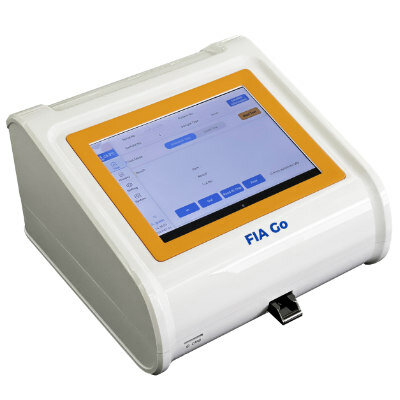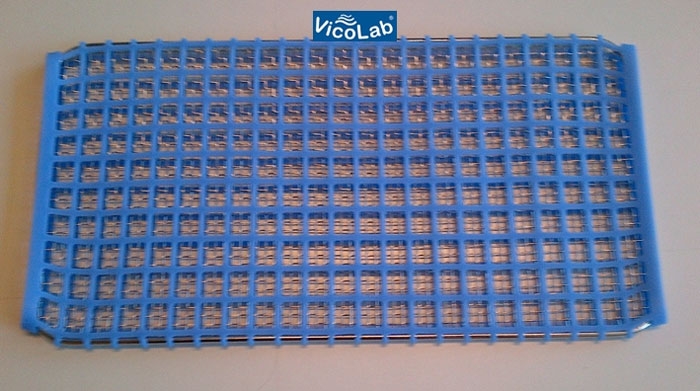AI Predicts Multiple Sclerosis Risk, Flags Potentially Contaminated Lab Results
|
By LabMedica International staff writers Posted on 27 Jul 2023 |

New research presented at the 2023 AACC Annual Scientific Meeting & Clinical Lab Expo has shown that an artificial intelligence (AI) model can predict the likelihood of individuals developing multiple sclerosis (MS) years before its diagnosis. Such prediction could allow for earlier treatment initiation, potentially slowing the progression of this neurological disorder. Breaking results from another study have revealed that machine learning (ML) can be instrumental in identifying laboratory samples contaminated with intravenous fluids. This important discovery could help minimize laboratory errors that tend to slow down diagnosis, increase healthcare expenses, and lead to incorrect treatments. Both these studies indicate the huge strides made in the use of AI and ML to enhance patient care.
MS, a disease of the nervous system, affects over 2.8 million people globally. While its exact cause remains unclear, the disease is linked to autoimmunity, where the immune system mistakenly attacks healthy cells, as well as to genetics, the Epstein-Barr virus, and other factors. Currently, MS diagnosis relies on imaging, cerebrospinal fluid studies, and clinical history. However, there is a need for early-detection methods as they could help start treatment earlier, thus slowing down disease progression.
In the first study, a team of researchers at Siemens Healthineers (Erlangen, Germany) trained machine-learning models to predict the risk of MS. Over 3,000 data sets from the electronic health records of MS patients and others were used for the study. Their "random forest model" parses data on a patient’s age, gender, blood, and metabolic markers, obtained up to three years prior to diagnosis. The model demonstrated high accuracy and strong predictive ability. The key factors contributing to the model's ability to identify high-risk patients were blood measurements of neutrophils, red blood cells, and other markers. These predictions remained consistent up to three years before diagnosis.
“Our model’s performance suggests that AI-based prediction models could identify the risk for multiple sclerosis years before neurological symptoms appear,” said Raj Gopalan, MD, at Siemens Healthineers who led the research team. “This could reveal which patients should be monitored for periodic neurological and cognitive exams when symptoms appear. In addition, early confirmation of the diagnosis with imaging and cerebrospinal fluid studies could facilitate disease-modifying treatment.”
In a separate study, a research team led by scientists at Washington University School of Medicine in St. Louis (St. Louis, MO, USA) used a "mixture-of-experts" modeling technique to develop an ML-based system capable of detecting instances of IV fluid contamination that were missed by manual methods. Currently, scientists are utilizing ML to identify potential contaminations in lab samples that could affect test results. When samples are collected directly from IV catheters instead of a fresh blood draw, the fluid within can lead to false lab results that delay diagnosis, increase healthcare costs, and result in incorrect treatments. Existing contamination detection methods are not always reliable and often require technicians to undertake extensive manual analysis.
The research team gathered over 9.6 million chemistry results from patients and simulated IV fluid contamination in some samples with common IV solutions. By training different machine-learning models using the simulated results, they generated a final set of predictions. The models detected significant contamination in several thousand samples. The newly-developed pipeline is capable of detecting 5 to 10 times more contaminated samples compared to the existing methods. A vast majority of these tests evaded being previously flagged using manual methods –up to 94% in the case of samples contaminated with lactated Ringer's solution.
“While this won’t immediately reduce the number of contaminated tests, it will hopefully substantially reduce the operational and clinical impact of these events when they do happen, and provide us with a better quality metric with which we can prioritize areas for improvement initiatives,” said Nicholas Spies, MD, at Washington University School of Medicine in St. Louis, who led the research team.
Related Links:
Siemens Healthineers
Washington University School of Medicine in St. Louis
Latest AACC 2023 News
- First-of-Its-Kind Single-Cell Clinical Microbiology Platform Wins 2023 Disruptive Technology Award
- Ground-Breaking Phage-Based Diagnostic Kit for Laboratory Tuberculosis Testing Presented at AACC 2023
- Laboratory Experts Show How They Are Leading the Way on Global Trends
- Unique Competition Focuses on Using Data Science to Forecast Preanalytical Errors
- Best Approach to Infectious Disease Serology Testing for Laboratorians and Clinicians Discussed at AACC 2023
- Breaking Research Throws Light on COVID, Flu, and RSV Co-Infections
- New Research Shows Self-Collected Tests Perform Similarly to Provider-Collected Tests for Detecting STIs
- Scientific Session Explores Role of Technology in New Era of Specimen Transport
- Prevencio Presents AI-Driven Platform for Medical Diagnostic Test Development
- Scientific Session Explores Future Role of AI and ML in Clinical Laboratory
- SARSTEDT Demonstrates Pre-Analytic Innovations for Improving Specimen Quality, Reducing TAT and Automating Labs
- World's First Large Sample Volume, Open-Assay, Super-fast, Ultra-Sensitive, and Sample-To-Answer PCR Instrument
- Vital Biosciences Unveils Revolutionary POC Lab Testing Platform
- World's Smallest POC Device for Complete Blood Count in 30 Minutes Unveiled
- General Biologicals Unveils CTC Cancer Detection Products and Automated Molecular System
- Fapon Showcases Innovative Diagnostic and Biopharma Solutions
Channels
Clinical Chemistry
view channel
3D Printed Point-Of-Care Mass Spectrometer Outperforms State-Of-The-Art Models
Mass spectrometry is a precise technique for identifying the chemical components of a sample and has significant potential for monitoring chronic illness health states, such as measuring hormone levels... Read more.jpg)
POC Biomedical Test Spins Water Droplet Using Sound Waves for Cancer Detection
Exosomes, tiny cellular bioparticles carrying a specific set of proteins, lipids, and genetic materials, play a crucial role in cell communication and hold promise for non-invasive diagnostics.... Read more
Highly Reliable Cell-Based Assay Enables Accurate Diagnosis of Endocrine Diseases
The conventional methods for measuring free cortisol, the body's stress hormone, from blood or saliva are quite demanding and require sample processing. The most common method, therefore, involves collecting... Read moreMolecular Diagnostics
view channel
Unique Autoantibody Signature to Help Diagnose Multiple Sclerosis Years before Symptom Onset
Autoimmune diseases such as multiple sclerosis (MS) are thought to occur partly due to unusual immune responses to common infections. Early MS symptoms, including dizziness, spasms, and fatigue, often... Read more
Blood Test Could Detect HPV-Associated Cancers 10 Years before Clinical Diagnosis
Human papilloma virus (HPV) is known to cause various cancers, including those of the genitals, anus, mouth, throat, and cervix. HPV-associated oropharyngeal cancer (HPV+OPSCC) is the most common HPV-associated... Read moreHematology
view channel
Next Generation Instrument Screens for Hemoglobin Disorders in Newborns
Hemoglobinopathies, the most widespread inherited conditions globally, affect about 7% of the population as carriers, with 2.7% of newborns being born with these conditions. The spectrum of clinical manifestations... Read more
First 4-in-1 Nucleic Acid Test for Arbovirus Screening to Reduce Risk of Transfusion-Transmitted Infections
Arboviruses represent an emerging global health threat, exacerbated by climate change and increased international travel that is facilitating their spread across new regions. Chikungunya, dengue, West... Read more
POC Finger-Prick Blood Test Determines Risk of Neutropenic Sepsis in Patients Undergoing Chemotherapy
Neutropenia, a decrease in neutrophils (a type of white blood cell crucial for fighting infections), is a frequent side effect of certain cancer treatments. This condition elevates the risk of infections,... Read more
First Affordable and Rapid Test for Beta Thalassemia Demonstrates 99% Diagnostic Accuracy
Hemoglobin disorders rank as some of the most prevalent monogenic diseases globally. Among various hemoglobin disorders, beta thalassemia, a hereditary blood disorder, affects about 1.5% of the world's... Read moreImmunology
view channel
Diagnostic Blood Test for Cellular Rejection after Organ Transplant Could Replace Surgical Biopsies
Transplanted organs constantly face the risk of being rejected by the recipient's immune system which differentiates self from non-self using T cells and B cells. T cells are commonly associated with acute... Read more
AI Tool Precisely Matches Cancer Drugs to Patients Using Information from Each Tumor Cell
Current strategies for matching cancer patients with specific treatments often depend on bulk sequencing of tumor DNA and RNA, which provides an average profile from all cells within a tumor sample.... Read more
Genetic Testing Combined With Personalized Drug Screening On Tumor Samples to Revolutionize Cancer Treatment
Cancer treatment typically adheres to a standard of care—established, statistically validated regimens that are effective for the majority of patients. However, the disease’s inherent variability means... Read moreMicrobiology
view channel
Mouth Bacteria Test Could Predict Colon Cancer Progression
Colon cancer, a relatively common but challenging disease to diagnose, requires confirmation through a colonoscopy or surgery. Recently, there has been a worrying increase in colon cancer rates among younger... Read more.jpg)
Unique Metabolic Signature Could Enable Sepsis Diagnosis within One Hour of Blood Collection
Sepsis is a life-threatening condition triggered by an extreme response of the body to an infection. It requires immediate medical intervention to prevent potential death or lasting damage.... Read morePathology
view channel
Spatial Tissue Analysis Identifies Patterns Associated With Ovarian Cancer Relapse
High-grade serous ovarian carcinoma is the most lethal type of ovarian cancer, and it poses significant detection challenges. Typically, patients initially respond to surgery and chemotherapy, but the... Read more.jpg)
Unique Hand-Warming Technology Supports High-Quality Fingertip Blood Sample Collection
Warming the hand is an effective way to facilitate blood collection from a fingertip, yet off-the-shelf solutions often do not fulfill laboratory requirements. Now, a unique hand-warming technology has... Read moreTechnology
view channel
New Diagnostic System Achieves PCR Testing Accuracy
While PCR tests are the gold standard of accuracy for virology testing, they come with limitations such as complexity, the need for skilled lab operators, and longer result times. They also require complex... Read more
DNA Biosensor Enables Early Diagnosis of Cervical Cancer
Molybdenum disulfide (MoS2), recognized for its potential to form two-dimensional nanosheets like graphene, is a material that's increasingly catching the eye of the scientific community.... Read more
Self-Heating Microfluidic Devices Can Detect Diseases in Tiny Blood or Fluid Samples
Microfluidics, which are miniature devices that control the flow of liquids and facilitate chemical reactions, play a key role in disease detection from small samples of blood or other fluids.... Read more
Breakthrough in Diagnostic Technology Could Make On-The-Spot Testing Widely Accessible
Home testing gained significant importance during the COVID-19 pandemic, yet the availability of rapid tests is limited, and most of them can only drive one liquid across the strip, leading to continued... Read moreIndustry
view channel
ECCMID Congress Name Changes to ESCMID Global
Over the last few years, the European Society of Clinical Microbiology and Infectious Diseases (ESCMID, Basel, Switzerland) has evolved remarkably. The society is now stronger and broader than ever before... Read more
Bosch and Randox Partner to Make Strategic Investment in Vivalytic Analysis Platform
Given the presence of so many diseases, determining whether a patient is presenting the symptoms of a simple cold, the flu, or something as severe as life-threatening meningitis is usually only possible... Read more
Siemens to Close Fast Track Diagnostics Business
Siemens Healthineers (Erlangen, Germany) has announced its intention to close its Fast Track Diagnostics unit, a small collection of polymerase chain reaction (PCR) testing products that is part of the... Read more


















